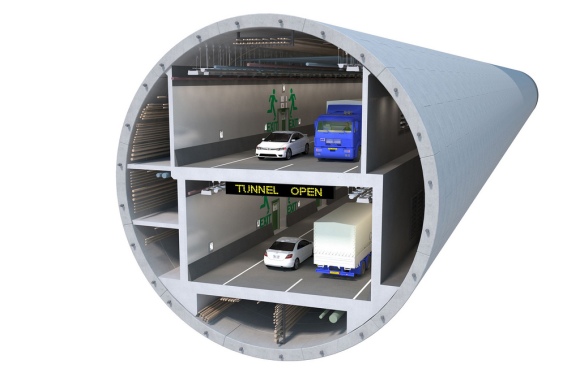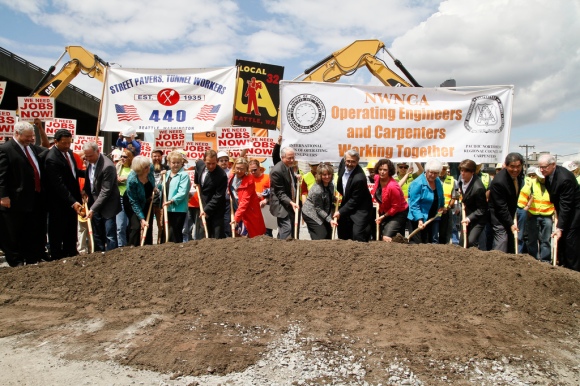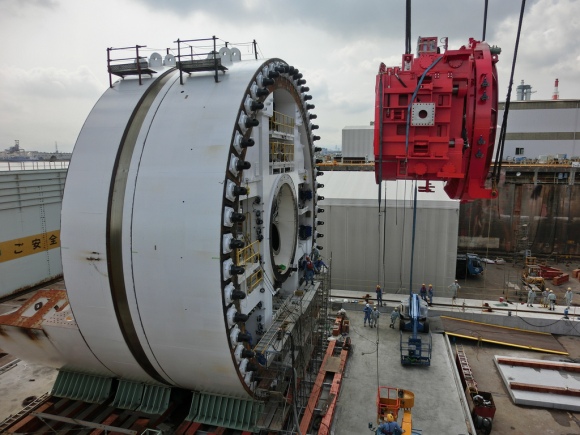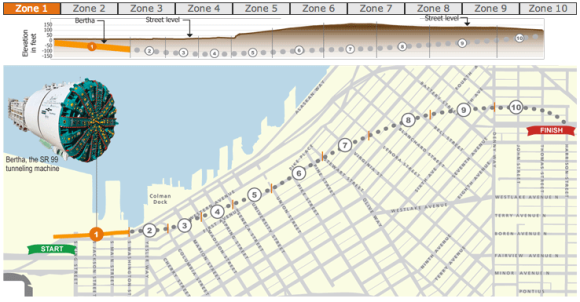
A view of State Route 99 Alaskan Way Viaduct double-deck highway through downtown, which will be replaced with a bored tunnel.
(Credit: Washington State Department of Transportation)
In 2001, an earthquake rocked Seattle for a terrifying 45-second span, causing hundreds of injuries and $1 billion to $4 billion in damage. One structure that withstood the earthquake was the Alaskan Way Viaduct. While still standing, this double-deck highway that runs through the city’s downtown had sunk several inches and would have likely collapsed if the earthquake had continued any longer. While crews were able to stabilize the structure, it was ultimately deemed that replacement of the viaduct was the best course of action. What followed, for nearly a decade, were the aftershocks of public discourse and political debate to determine the best replacement option. This led to one of the most scrutinized public participation processes in the state’s history, including more than 90 alternative options for the viaduct’s replacement. By 2009, advancements in technology made the best option for the viaduct’s waterfront section clear – a bored tunnel. This option was the only alternative that would allow the busy State Route 99 to remain open during the majority of construction and maintain a connection to and through the city’s downtown.
Fast-forward to today and the project is now home to the world’s largest-diameter tunneling machine, named Bertha after Seattle’s first female mayor. Weighing in at 7,000 tons, Bertha is charged with digging a tunnel beneath downtown Seattle. She began her work in July and once the digging is complete the viaduct will be demolished and replaced with a new tunnel to carry traffic along this bustling portion of State Route 99. The Washington State Department of Transportation (WSDOT) has made it easy for the public to track Bertha’s progress by allowing people to follow her journey online or via social media. Bertha has her own Twitter account and WSDOT regularly posts photos of construction.

A design concept of the State Route 99 tunnel that will replace the State Route 99 Alaskan Way Viaduct.
(Credit: Washington State Department of Transportation)
The project is currently halfway complete with the viaduct’s southern mile having been replaced with a more earthquake resistant and wider side-by-side roadway in 2011. This portion of the program was completed one year ahead of schedule and within budget, a Bertha-sized feat when it comes to large-scale infrastructure projects. The two sections will eventually connect in late 2015, when the new State Route 99 tunnel is anticipated to open to traffic.
This month, as we explore some of the world’s largest projects, the Collaborative Services blog spoke with KaDeena Yerkan, the Manager of Communications and Public Involvement for WSDOT’s Alaskan Way Viaduct Replacement Program to learn more about the project’s history, the challenges it has faced along the way, and how the Department is continuing to use new and traditional methods for keeping the community informed of the program’s progress. Can you dig it?
– – –
Reaching a consensus on the best way to replace the viaduct after the devastating earthquake in 2001 was not easy. How did the public come to support the version of the project now under construction?
The public was integral in shaping our plans for replacing the viaduct. The recommendation to replace the viaduct with a bored tunnel and other improvements came after a stakeholder group spent most of 2008 studying potential replacement alternatives. Options included elevated, tunnel and surface replacements. The tunnel was ultimately chosen because it was the only alternative that would allow us to maintain traffic on State Route 99 – one of two main north-south routes through downtown Seattle – during construction.

The groundbreaking ceremony at the State Route 99 South Holgate Street to South King Street Project in June 2010. This project replaced the south end of State Route 99.
(Credit: Washington State Department of Transportation)
What are some lessons learned from the project’s contentious history?
Large projects demand thoughtful and inclusive planning, particularly when so many different stakeholders are involved. In addition to serving more than 100,000 vehicles per day, the viaduct is located in a dense urban area near two sports stadiums and the Port of Seattle’s busiest freight terminal. Gathering extensive input from all corners of the community was essential to selecting the best replacement alternative. There is no one solution that will make everyone happy, but by holding a thorough, transparent process we were able to gain public acceptance.
How do you keep the public informed about the status of the project and any construction-related impacts? What public outreach tools do you find most effective?
Communicating information about the project is an important priority. We use a variety of tools to inform and engage the public, including our website, social media, and presentations to community groups and professional organizations. We also staff information booths at community events and have a public information center near the work zone that has seen more than 18,000 visitors since it opened its doors in December 2011.

Crews ease the State Route 99 tunnel boring machine’s segment erector into place.
(Credit: The Washington State Department of Transportation)
The project is using the world’s largest-diameter tunneling machine, lovingly named Bertha. What can you tell us about Bertha and what can she accomplish in one day’s work?
At 57.5 feet in diameter – roughly as tall as a five-story building – our tunneling machine is the world’s largest. The machine was shipped to Seattle on the Jumbo Fairpartner, after successfully undergoing testing in Osaka, Japan, where it was built. It arrived in Elliott Bay on April 2, 2013, and was reassembled in an 80-foot-deep pit to the west of Seattle’s stadiums. Tunneling began on July 30, 2013 and is expected to take approximately 14 months.
Bertha weighs about 7,000 tons and is about the same size as some of the largest state ferries that ply the waters of Puget Sound. The Japanese firm Hitachi Zosen Corporation manufactured the machine for Seattle Tunnel Partners (STP), the contracting team that’s building the tunnel. Hitachi has successfully built more than 1,300 tunneling machines, a number of them for large-diameter tunnel projects. The machine will not officially become the property of STP until it has tunneled approximately 1,000 feet without any issues. As owner of the machine, STP is responsible for ensuring it functions properly.
Check out this short video to see the inner workings of a tunneling machine. Our Flickr site has photos of the machine’s journey from the manufacturing plant to its July 2013 launch beneath downtown.

To make Bertha’s journey easier to follow the Washington State Department of Transportation has divided her route into 10 unique zones.
(Credit: Washington State Department of Transportation)
The Washington State Department of Transportation has used social media to help the public track Bertha’s progress and to stay up to date on the project. How has the use of social media led to more effective communication efforts?
Social media is a valuable part of our communications efforts. It allows us to interact with the public in ways that weren’t previously possible, helping us reach new audiences and provide them with photos, videos and links to other information about the project. As important as social media has become, it is only one part of our broader communications strategy. Because many people don’t use social media, we still rely heavily on more traditional tools. Our project hotline, for example, allows people to speak with a staff member about their questions or concerns. We also make it a point to visit fairs and festivals in the area, in addition to presenting to local community groups, so that people can connect with our team in person. Our team has embraced social media, but face-to-face communication remains one of our strongest tools.
Half of the viaduct has already been replaced, and the project is within budget and ahead of schedule. What have been some of the biggest challenges to accomplishing this?
Our job is to replace this vital stretch of highway while minimizing disruptions to traffic and the surrounding area. Balancing those two responsibilities isn’t easy, particularly with a project that is located near so many busy facilities that depend on their access to and from State Route 99. We also faced a very tight schedule and political challenges due to controversy about which alternative should replace the waterfront section of the viaduct. Finally, there are numerous technical challenges associated with a project of this magnitude, including designing and building the tunneling machine and launch pit, building the roadway within the tunnel and implementing a comprehensive program to protect structures above and near the tunnel route.
– – –
We wish Bertha the best of luck as she continues building the State Route 99 tunnel. Follow Bertha’s progress on Twitter at @BerthaDigsSR99.
Liz Faris, Account Manager
Collaborative Services, Inc.


Recent Comments